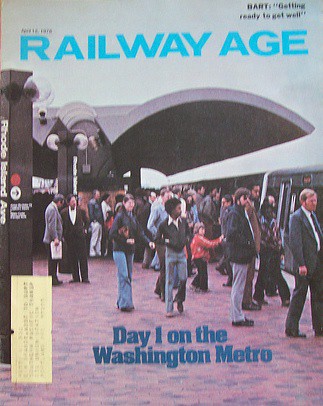Transit ridership rises nationally, drops in the DC region
According to "Use of public transportation jumps" from the Los Angeles Times, transit ridership is increasing nationally, likely in response to tighter household budgets, gasoline price increases, etc., using the most recent data from the American Public Transportation Association. Ridership is up 2.6% nationally, and a bit less, under 2% in Los Angeles.
But after raising fares last year, WMATA reports ("Metrorail ridership drops 5 percent below agency's target" from the Examiner) that ridership has dropped. Also see "If not Metro fare increases, what does it take to unite riders?" from the Post's Dr. Gridlock column.
 The WMATA system is an odd combination of a local railroad commuter system and subway system and has a fare structure more like railroads, based on distance, whereas most other subway and light rail systems have lower average fares that are not distance based.
The WMATA system is an odd combination of a local railroad commuter system and subway system and has a fare structure more like railroads, based on distance, whereas most other subway and light rail systems have lower average fares that are not distance based.Typically systems charge a flat fare ranging from $1.50 to $2.50, with the exception of the BART system in the San Francisco Bay area, which is set up the same way as the WMATA system, and surprisingly has higher maximum fares (+ surcharges to go to the San Francisco International Airport and to go through the Transbay Tube) but a slightly lower base fare and they don't charge different prices for peak-time vs. off-peak service (they also have about half the ridership of the WMATA system).
Most other transit systems have a less complicated fare structure and flat fares (although they may charge an additional fee for a transfer). Some systems have an all-day pass, some don't, and most offer weekly and monthly passes that provide discounts as well.
Plus, WMATA's regular weekend track maintenance programs seriously discourages people from using transit then, because the service becomes less efficient and much less reliable.
Labels: transit, transit fares, transit marketing



10 Comments:
Readers shouldn't jump to think that the decrease in DC's metro ridership means more cars on the road. While metro may be decreasing, Capital Bikeshare ridership is increasing.
hardly a significant mode in terms of overall mobility in the city, at least not yet.
Anecdotally, I am starting to see noticeable numbers of bike share users. But noticeable doesn't mean significant.
what bothers me is the new statistics report that shows 75 % of bicyclists in DC are male- this has GOT TO CHANGE- they need safer auto-protected bikeways and less of these silly in-the-road bike lanes that are meant for vehicular cycling. I personally will NOT use the bike lane in Pa Avenue as it is simply DANGEROUS and that street has lovely super- wide sidewalks that are surprisingly empty most of the time. The planners need to get over their fear of sidewalks and get more cyclists using them- and then we will have women and children cycling just like in Europe.
I know that dedicated infrastructure is essential. However, there are a number of DC streets that have low enough traffic that they function as a kind of bike boulevard. While they wouldn't work super well for children, they ought to be ok for women--in fact I was clued into how 5th St. NW, south of Grant Circle, functions as a superior bike route (it has a continuous bike lane not a cycletrack) by a female colleague.
So it's not just infrastructure, it's programming too.
Riding 5th St. NW, it pops out around the McMillan Reservoir, it's really nice. Not as nice as a trail where you don't have to worry about car traffic at all, but still very nice.
my friend Sarah Davies, who owned the Charlie Horse Company- was almost killed riding her bicycle near the relatively traffic calmed area around Marion Park- a police car hit her and left her almost paralysed- she is still sufferring from the complications- this was two years ago- she was going slow and riding int he road obeying the "rules". This is yet another instance of where "vehicular cycling" gets dangerous- when you least expect it someone hits you in a "safe place".Again- our planners need to get over their silly inhibitions against sidewalk usage by cyclists- they need to study how it actually works in Germany and Holland and Denmark.
http://www.bicyclinglife.com/NewsAndViews/Gender.htm
In terms of bikeshare, my own anecdote it hasn't changed my driving behavior much -- because I don't drive a lot. It has changed my transit usage. Bikeshare members reported large savings which is probably mostly money NOT being spent at WMATA. In my case, about $500 a year.
Again, absolute numbers no. On the margins, yes.
That wouldn't surprise me. My bike use comes at the expense of WMATA for sure. I ride the subway only a couple times/week.
That's ok in terms of reducing, marginally, some of the negative impacts of overcrowding, a particular benefit with bikeshare in Montreal, where the subway system uses much smaller cars than DC. (It has 50% more subway ridership than DC, in a smaller footprint, so it's more congested.)
(I definitely ride the subway on Mondays if I shop at Harris-Teeter in NoMA, because I don't want to ride up the hill with groceries. But if I go back via Georgia Avenue, I just ride home as I don't mind that hill so much. If I want to go to H-T that bad, I can go to the one in Kalorama.)
Post a Comment
<< Home